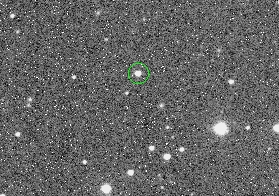69230 Hermes

Recovery of Hermes on Oct. 15, 2003.
|
|
| Discovery [1] | |
|---|---|
| Discovered by | Karl Reinmuth |
| Discovery site | Heidelberg Obs. |
| Discovery date | 28 October 1937 |
| Designations | |
| MPC designation | 69230 Hermes |
|
Named after
|
Hermes |
| 1937 UB | |
| Apollo, NEO, PHA Mars-crosser Venus-crosser |
|
| Orbital characteristics [1] | |
| Epoch 27 June 2015 (JD 2457200.5) | |
| Uncertainty parameter 0 | |
| Observation arc | 77.74 yr (28,396 days) |
| Aphelion | 2.6877 AU |
| Perihelion | 0.6222 AU |
| 1.6550 AU | |
| Eccentricity | 0.6240 |
| 2.13 yr (777.68 days) | |
|
Average orbital speed
|
20.70 km/s |
| 145.48° | |
| Inclination | 6.0675° |
| 34.232° | |
| 92.735° | |
| Earth MOID | 0.0043 AU |
| Physical characteristics | |
| Dimensions | 300–450 m[2] |
| Mass | 6.7×1010 kg |
| 13.894 h 13.892±0.006 h[3] |
|
| 0.25±0.12[3] | |
| Temperature | ~ 216 K [citation needed] |
| S [lower-alpha 1] | |
| 17.5 | |
69230 Hermes is an Apollo, Mars- and Venus-crosser binary asteroid[2] that passed Earth at about twice the distance of the Moon on October 30, 1937. It is named after the Greek god Hermes.
At the time, this was the closest known approach of an asteroid to the Earth. Not until 1989 was a closer approach (by 4581 Asclepius) observed. At closest approach, Hermes was moving 5° per hour across the sky and reached 8th magnitude.
It was discovered by Karl Reinmuth in images taken at Heidelberg Observatory on October 28, 1937. Only four days of observations could be made before Hermes became too faint to be seen in the telescopes of the day.[4] This was not enough to calculate an orbit, and Hermes was "lost" (see Lost asteroids).[4] It thus did not receive a number, but Reinmuth nevertheless named it after the Greek god Hermes. It was the only unnumbered but named asteroid, having only the provisional designation 1937 UB.
On October 15, 2003, Brian A. Skiff of the LONEOS project made an asteroid observation that, when the orbit was calculated backwards in time (by Timothy B. Spahr, Steven Chesley and Paul Chodas), turned out to be a rediscovery of Hermes. The orbit is now well known, and Hermes has been assigned sequential number 69230. In retrospect it turned out that Hermes came even closer to the Earth in 1942 than in 1937, within 1.7 Moon distances, without being observed.[5] On October 30, 1937, it passed 0.00494 AU (739,000 km; 459,000 mi) from the Earth and on April 26, 1942, it passed 0.0042415 AU (634,520 km; 394,270 mi) from Earth.[5]
Hermes is an S-type asteroid, a classification first reported by Andy Rivkin and Richard Binzel.[lower-alpha 1]
Radar observations led by Jean-Luc Margot at Arecibo Observatory and Goldstone in October and November 2003 showed Hermes to be a binary asteroid. The primary and secondary components have nearly identical radii of 300–450 m (980–1,480 ft),[2] and their orbital separation is only 1,200 metres.
In popular culture
- In the 1978 novel The Hermes Fall by John Baxter, the asteroid endangers the Earth in 1980.[6]
References
- ↑ 1.0 1.1 Lua error in package.lua at line 80: module 'strict' not found.
- ↑ 2.0 2.1 2.2 Lua error in package.lua at line 80: module 'strict' not found.
- ↑ 3.0 3.1 Lua error in package.lua at line 80: module 'strict' not found.
- ↑ 4.0 4.1 Lua error in package.lua at line 80: module 'strict' not found.
- ↑ 5.0 5.1 Lua error in package.lua at line 80: module 'strict' not found.
- ↑ Lua error in package.lua at line 80: module 'strict' not found.